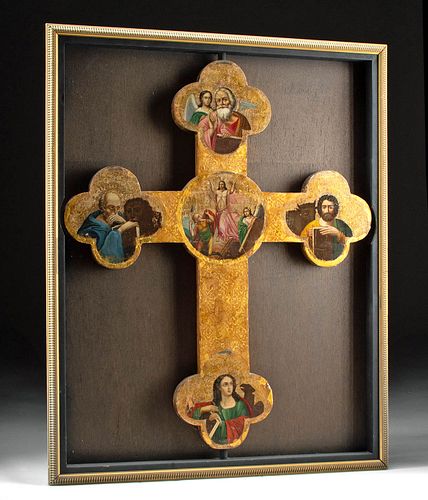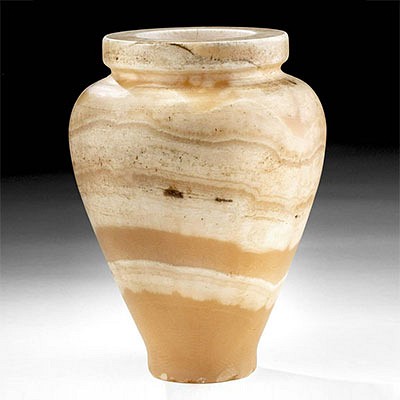Glistening 19th C. Russian Icon Processional Cross
Lot 165c
About Seller
Artemis Gallery
686 S Taylor Ave, Ste 106
Louisville, CO 80027
United States
Selling antiquities, ancient and ethnographic art online since 1993, Artemis Gallery specializes in Classical Antiquities (Egyptian, Greek, Roman, Near Eastern), Asian, Pre-Columbian, African / Tribal / Oceanographic art. Our extensive inventory includes pottery, stone, metal, wood, glass and textil...Read more
Categories
Estimate:
$2,500 - $4,000
Absentee vs Live bid
Two ways to bid:
- Leave a max absentee bid and the platform will bid on your behalf up to your maximum bid during the live auction.
- Bid live during the auction and your bids will be submitted real-time to the auctioneer.
Bid Increments
| Price | Bid Increment |
|---|---|
| $0 | $25 |
| $300 | $50 |
| $1,000 | $100 |
| $2,000 | $250 |
| $5,000 | $500 |
| $10,000 | $1,000 |
| $20,000 | $2,500 |
| $50,000 | $5,000 |
| $100,000 | $10,000 |
| $200,000 | $20,000 |
About Auction
By Artemis Gallery
Dec 17, 2020
Set Reminder
2020-12-17 10:00:00
2020-12-17 10:00:00
America/New_York
Bidsquare
Bidsquare : VARIETY SALE | Antiquities & Ethnographic Art
https://www.bidsquare.com/auctions/artemis-gallery/variety-sale-antiquities-ethnographic-art-6207
Featuring classical antiquities, ancient and ethnographic art from cultures encompassing the globe. Egyptian, Greek, Roman, Etruscan, Near Eastern, Asian, Pre-Columbian, Native American, African / Tribal, Oceanic, Spanish Colonial, Russian, Fossils, Fine Art, more! Artemis Gallery info@artemisgallery.com
Featuring classical antiquities, ancient and ethnographic art from cultures encompassing the globe. Egyptian, Greek, Roman, Etruscan, Near Eastern, Asian, Pre-Columbian, Native American, African / Tribal, Oceanic, Spanish Colonial, Russian, Fossils, Fine Art, more! Artemis Gallery info@artemisgallery.com
- Lot Description
Eastern Europe, Russia, ca. 19th century CE. Finely painted in egg tempera on wood, the painted iconography set amidst glistening gold leaf strapwork patterns, an icon in the form of a very large processional cross or crucifix, possibly carried during Christian processions, depicting Christ in Resurrection at the center - rising from the doors of Hades with two accompanying figures, a man holding a spear perhaps representing Satan and the angel whom Christ commanded to bind Satan, this scene surrounded by depictions of the four Evangelists with their symbols occupying the fleur-di-lis-like termini of each arm. Alternatively, the man with the spear may represent the centurion who guarded the body, and the angel may represent the man in white who appeared to the myrrh-bearing women. The cross is mounted in an open shadow-box of sorts, comprised of a stained wood background with a gold-toned frame detailed with curved frets and a beaded inner border. Size: frame measures 31" W x 38.5" H (78.7 cm x 97.8 cm), cross measures 27.5" W x 34.5" H (69.8 cm x 87.6 cm)
Each of the Evangelists is depicted half-length, holding his Gospel, accompanied by his symbol. One can imagine Matthew, Luke, John, and Mark - each Evangelist seated in his scriptorium, writing his Gospel surrounded by shelves for volumes and scrolls, parchments, quills, erasing knives, and inks. Images of the Evangelists derived from miniatures of illuminated Gospel books and Gospel lectionaries showing them at work in their scriptoria. These portrayals were oftentimes painted on the outside of the Royal Doors.
The writings of Matthew (depicted at the top central terminus) are typically shown to be inspired by an angel, or after the 14th century, by Sophia Wisdom, the wingless female figure with a scepter and crowned by a double star halo. The Church Fathers assigned each evangelist one of the four living creatures of the Apocalypse, and Matthew’s symbol was the “son of man” since his writings begin with the human genealogy of Christ. According to Irenaeus of Lyon, “The Word of God made its home among men and became the Son of Man to accustom man to understanding God, and to accustom God to making His home among men.”
Saint Luke (depicted at right terminus) is also known as Luke the Painter, because as the author of the “Gospel of Jesus’s Childhood” he is believed to have been the first artist to portray Mary with the Christ Child. This understanding is based upon ancient icons from Thebes and Antioch attributed to the evangelist, later transferred to Russia and Constantinople. As the first to paint the Theotokos (Mother of God), Luke’s icons include the Hodegetria of the Constantinople Church of the Blachernae, which legend tells us restored the eyesight of two blind men – hence, the name Hodegetria meaning, “She who gives sight” or “shows the way” – as well as the Virgin of Smolensk, a prototype for numerous Marian icons that came to Russia in the 12th century. Luke’s symbol is the ox or calf, because his Gospel begins with a sacrifice that Zechariah (John the Baptist’s father) made.
Saint John’s symbol is the eagle (lower terminus), chosen for the “sublime manner in which he described the godliness of the Word” according to Christian iconography expert Alfredo Tradigo, who writes, “of all the evangelists, he flew the highest.” (Tradigo, Icons and Saints of the Eastern Orthodox Church, Getty Museum, 2006, p. 262) Also known as John the Theologian for his ability to channel divine wisdom, Saint John wrote the fourth Gospel (the Book of Revelation), while living in a cave on the isle of Patmos, exiled by Emperor Trajan. There he dictated a dramatic vision of the Apocalypse to the deacon Prochorus, his disciple and steadfast companion. John also wrote the “Gospel of Love” or the “flower of the Gospel” as Origen calls it – in addition to three of the Catholic Epistles. In the words of Patriarch Athenagoras, “John is the source of our loftiest spirituality. Like him, those who are silent know the mysterious confusion that can assail the heart; invoking the presence of John, their hearts catch fire.” (Tradigo, 262)
Finally, Saint Mark (left terminus) is identified with the winged lion, because his Gospel begins with the figure of John the Baptist, man of the desert. Mark was regarded as an astute chronicler, and being well-versed in Latin, accompanied the apostle Paul to Rome where he served as his interpreter.
Exhibited in "Windows Into Heaven: Russian Icons from the Lilly and Francis Robicsek Collection of Religious Art" at the Mint Museum of Art, Charlotte, North Carolina (December 20, 2003 through February 22, 2004) which presented highlights of one of the world's great artistic traditions through an extraordinary group of sixty-five 18th and 19th century Russian icons on loan from the private collection of Lilly and Francis Robicsek.
Icons (icon means "image" in Greek) are sacred objects within the Eastern Orthodox Christian tradition. Found in homes as well as churches, these painted images depict holy persons and saints as well as illustrate scenes from the Scriptures. Some icons are encased in precious metal covers (oklads) adorned with pearls and semi-precious stones or glass-fronted wooden cases (kiots). This example is set in a shadow-box-like frame. Icons are not worshiped, but are instead venerated for their ability to focus the power of an individual's prayer to God. As such they are truly "windows into heaven."
The “Windows Into Heaven” exhibition profiled a magnificent chapter of Russian artistry, the embrace of the Russian Orthodox faith of religious icons during the Romanov centuries. The Russian religious faith was an offshoot of Byzantine Christianity, which in 1054 parted ways from Roman Catholicism. Icons were and continue to be religious images created for veneration. As a focus for prayers and meditation for believers, icons serve as “windows into heaven.”
Provenance: private Francis & Lilly Robicsek Collection, Charlotte, North Carolina, USA, acquired second half of the 20th century; exhibited at Mint Museum of Art "Windows Into Heaven", Charlotte, North Carolina (December 20, 2003 through February 22, 2004)
All items legal to buy/sell under U.S. Statute covering cultural patrimony Code 2600, CHAPTER 14, and are guaranteed to be as described or your money back.
A Certificate of Authenticity will accompany all winning bids.
We ship worldwide and handle all shipping in-house for your convenience.
#119615Age cracks and areas of restoration to central depiction of Christ. Expected surface wear and losses, particularly at peripheries, commensurate with age.Condition
- Shipping Info
-
All shipping is handled in-house for your convenience. Your invoice from Artemis Gallery will include shipping calculation instructions. If in doubt, please inquire BEFORE bidding for estimated shipping costs for individual items.
-
- Buyer's Premium



 EUR
EUR CAD
CAD AUD
AUD GBP
GBP MXN
MXN HKD
HKD CNY
CNY MYR
MYR SEK
SEK SGD
SGD CHF
CHF THB
THB




















